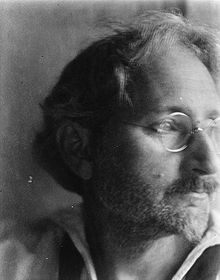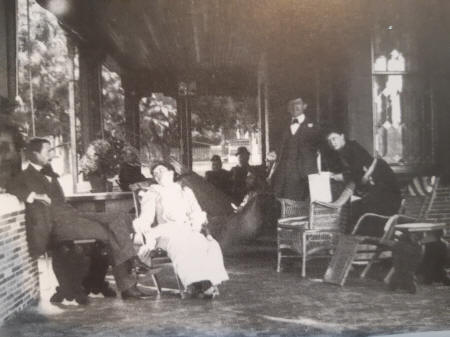

Queer Places:
93 Day St, Norwood, MA 02062, Stati Uniti
9 Pinckney St, Boston, MA 02114
 Fred Holland Day (Boston July 23, 1864[1]
- November 12, 1933) was an American photographer and publisher. He was the
first in the United States to advocate that photography should be considered a
fine art. A certain homoeroticism emerged, made all the more remarkable by the
fact that many prominent artists of this era—including
Thomas Eakins,
F. Holland Day,
John Singer Sargent,
Harriet Hosmer,
Edmonia Lewis, and
Anne Whitney—had intense romantic
attachments with members of their own sex.
Fred Holland Day (Boston July 23, 1864[1]
- November 12, 1933) was an American photographer and publisher. He was the
first in the United States to advocate that photography should be considered a
fine art. A certain homoeroticism emerged, made all the more remarkable by the
fact that many prominent artists of this era—including
Thomas Eakins,
F. Holland Day,
John Singer Sargent,
Harriet Hosmer,
Edmonia Lewis, and
Anne Whitney—had intense romantic
attachments with members of their own sex.
The Visionist believed in "art for art's sake" and in the nobility of artistic production over all other activities. Prominent Visionists were Herbert Copeland, Louise Imogen Guiney, Ralph Adams Cram, photographer and publisher F. Holland Day, poet Philip Savage and writer Alice Brown.
Day was the son of a Boston merchant, and was a man of independent means for all his life.
Day's life and works had long been controversial, since his photographic subjects were often nude male youths. Pam Roberts, in F. Holland Day (Waanders Pub, 2001; catalog of a Day exhibition at the Van Gogh Museum) writes: "Day never married and his sexual orientation, whilst it is widely assumed that he was homosexual, because of his interests, his photographic subject matter, his general flamboyant demeanor, was, like much else about him, a very private matter."
Day spent much time among poor immigrant children in Boston, tutoring them in reading and mentoring them. One in particular, the 13-year-old Lebanese immigrant Kahlil Gibran, went on to fame as the author of The Prophet.

Visionist Copeland, Guiney, Cram and Brown on the veranda of the Day
mansion in Norwood, 1892
Day co-founded and self-financed the publishing firm of Copeland and Day, which from 1893 through 1899 published about a hundred titles. The firm was influenced by the Arts and Crafts movement and William Morris's Kelmscott Press. The firm was the American publisher of Oscar Wilde's Salomé, illustrated by Aubrey Beardsley; The Yellow Book periodical, also illustrated by Beardsley; and The Black Riders and Other Lines by Stephen Crane. Copeland and Day also published Songs from Vagabondia, a book of poetry by Boston aesthetes Bliss Carman and Richard Hovey, lavishly illustrated by Thomas Meteyard.
He is known to have traveled. Beaumont Newhall states that he visited Algiers, possibly as a result of reading Wilde and Gide. There is a photo "Portrait of F. Holland Day in Arab Costume, 1901" by Frederick H. Evans.
He was a friend of Louise Imogen Guiney and Ralph Adams Cram, and member of social clubs, such as the "Visionists", formed around shared interests in arts and literature. He was a major patron of Aubrey Beardsley.
He was also a lifelong bibliophile and collector. Most notable among his collections was his world-class collection on the poet John Keats.
Amy Lowell had an unconventional work schedule, writing between midnight and 5.00AM. She often appeared late, even at gatherings she put togethe, so that Ada Dwyer Russell often played solo hostess at dinner for guests invited by Lowell. Some of her contemporaries and later critics considered her a bombastic, overly pushy woman, but she succeeded in getting the publisher and photographer F. Holland Day to share some of his John Keats memorabilia only through charm and flattery. While conducting his own research, Day had gained possession of a collection of 31 letters from Fanny Brawne to Keats. Day had long been obsessed with the poet. He began his Kears collection in 1885 and in 1894, he commissioned Anne Whitney to create a bust of Keats for the poet's parish church in Hempstead, England. However, Day refused to let anyone read the letters. Even his best friend, Louise Guiney, did not know what was in them, and Day put off Lowell's request to examine his treasures. Among the ostacles he placed before her was refusing all visits after 4.00PM, knowing that Lowell slept all day and worked all night and that it would be impossible for her to travel from her home in Brookline to Day's in Norwood in time for her to meet with him. But after a year of torment, Lowell gave in and agreed to Day's terms and she arrived at his house at 3.00 on March 2, 1922. Gleefully aware of her bulk, Day surrounded his bed with books, papers, teapots, and silverware while he had all the other furniture removed from his room except for a small armchair. "If Miss Lowell decides to sit down, she will hace to stay seated for the rest of the session." Lowell paced for the entire three hour visit. In the end, Lowell seduced Day with books on his favorite topics and a lock of Brawne's hair. Day allowed her access to some of the letters and the biography of Keats by Lowell was publised in 1925. Lowell died three months later.
My published books: